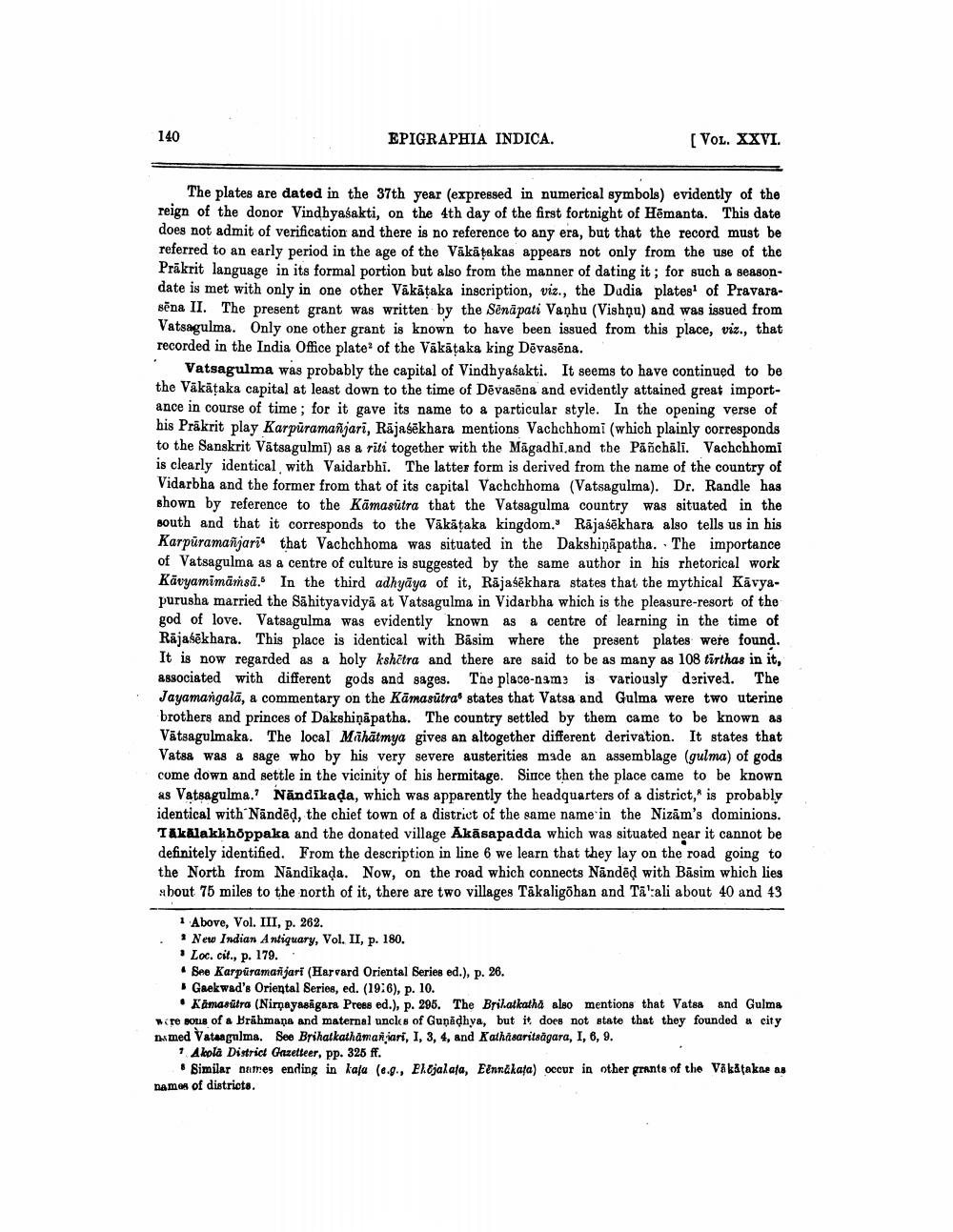________________
140
EPIGRAPHIA INDICA.
(VOL. XXVI.
The plates are dated in the 37th year (expressed in numerical symbols) evidently of the reign of the donor Vindhyasakti, on the 4th day of the first fortnight of Hēmanta. This date does not admit of verification and there is no reference to any era, but that the record must be referred to an early period in the age of the Vākātakas appears not only from the use of the Prakrit language in its formal portion but also from the manner of dating it ; for such a seasondate is met with only in one other Vākāțaka inscription, viz., the Dudia platest of Pravarasēna II. The present grant was written by the Sēnāpati Vaņhu (Vishņu) and was issued from Vatsagulma. Only one other grant is known to have been issued from this place, viz., that recorded in the India Office plate of the Vākāțaka king Dēvasēna.
Vatsagulma was probably the capital of Vindhyasakti. It seems to have continued to be the Vākāțaka capital at least down to the time of Dēvasēna and evidently attained great importance in course of time; for it gave its name to a particular style. In the opening verse of his Prākrit play Karpüramañjari, Rājasekhara mentions Vachchhomi (which plainly corresponds to the Sanskrit Vätsagulmi) as a riti together with the Māgadhi and the Panchāli. Vachchhomi is clearly identical with Vaidarbhi. The latter form is derived from the name of the country of Vidarbha and the former from that of its capital Vachchhoma (Vatsagulma). Dr. Randle has shown by reference to the Kamasutra that the Vatsagulma country was situated in the south and that it corresponds to the Vākātaka kingdom." Rajasekhara also tells us in his Karpuramañjarithat Vachchhoma was situated in the Dakshiņāpatha. The importance of Vatsagulma as a centre of culture is suggested by the same author in his rhetorical work Kāvyamīmāṁsā. In the third adhyāya of it, Rājasēkhara states that the mythical Kavyapurusha married the Sahityavidya at Vatsagulma in Vidarbha which is the pleasure-resort of the god of love. Vatsagulma was evidently known as a centre of learning in the time of Rājaśēkhara. This place is identical with Bāsim where the present plates were found. It is now regarded as a holy kshetra and there are said to be as many as 108 tirthas in it, associated with different gods and sages. The place-nam is variously derived. The Jayamangalā, a commentary on the Kāmasūtras states that Vatsa and Gulma were two uterine brothers and princes of Dakshiņāpatha. The country settled by them came to be known as Vätsagulmaka. The local Mühātmya gives an altogether different derivation. It states that Vatsa was a sage who by his very severe austerities made an assemblage (gulma) of gods come down and settle in the vicinity of his hermitage. Since then the place came to be known as Vatsagulma.? Nāndikada, which was apparently the headquarters of a district, is probably identical with Nanded, the chief town of a district of the same name in the Nizām's dominions. Takalakkhóppaka and the donated village Akāsapadda which was situated near it cannot be definitely identified. From the description in line 6 we learn that they lay on the road going to the North from Nändikada. Now, on the road which connects Nanded with Bāsim which lies about 75 miles to the north of it, there are two villages Tākaligőhan and Tā':ali about 40 and 43
1 Above, Vol. III, p. 262.
New Indian Antiquary, Vol. II, p. 180. • Loc. cit., p. 179.. • See Karpūramanjari (Harvard Oriental Series ed.), p. 26.
Gaekwad's Oriental Series, ed. (1986), p. 10.
• Kamasutra (Nirnayasagara Proes ed.), p. 295. The Brilatkatha also mentions that Vatsa and Gulma wire souls of a Brāhmaṇa and maternal uncles of Gunādhya, but it does not state that they founded a city Das med Vataagilma. See Brihatkathamanziari, 1, 3, 4, and Kathasaritsägara, I, 6, 9.
1 Alola District Gazetteer, pp. 325 ff.
Similar naures ending in kaja (6.9., Elijalata, Einnükata) occur in other grants of the Vakatakne as names of districts.




